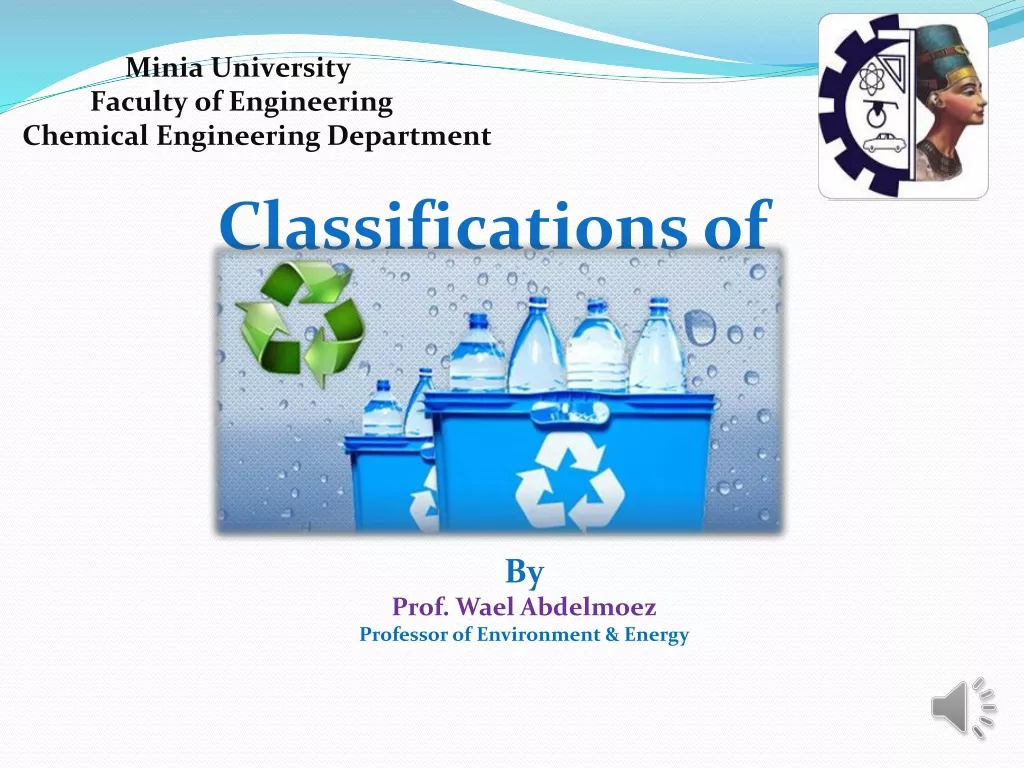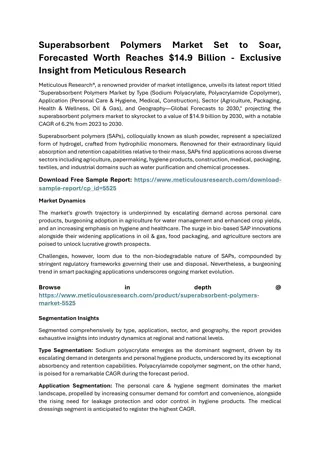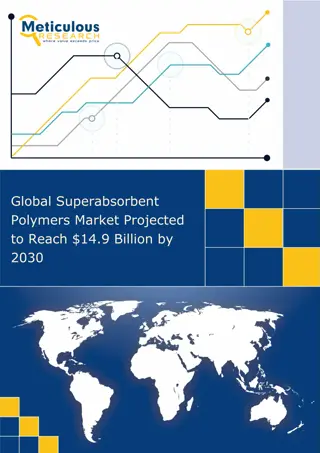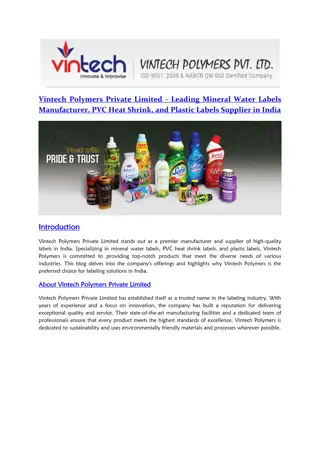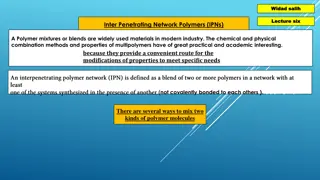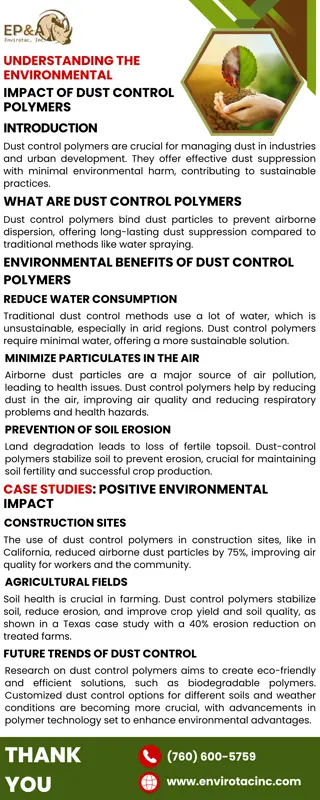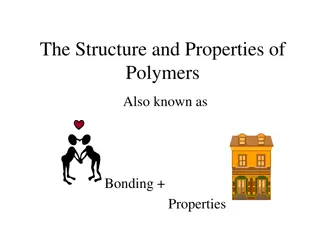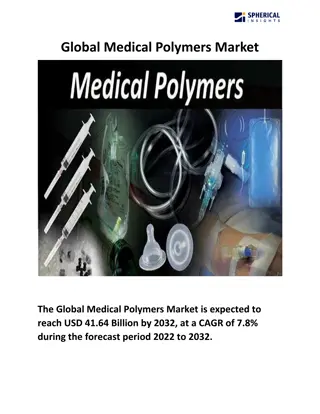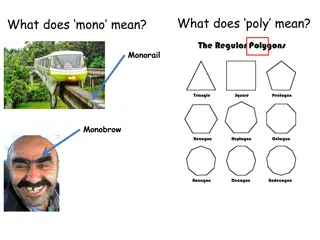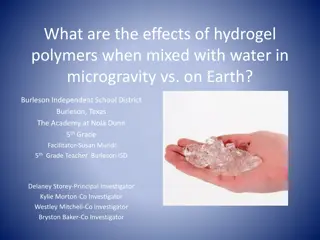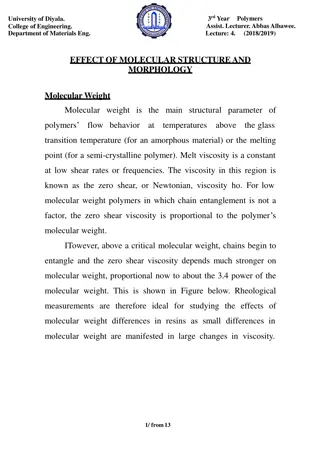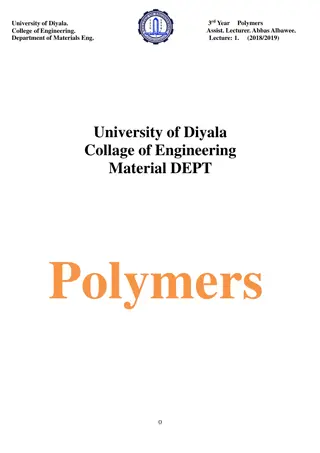
Polymers: Types, Characteristics, and Classification
Discover the world of polymers - long molecules consisting of monomers. Explore their properties, common examples, and ideal characteristics. Learn about natural and synthetic polymers, their sources, and classifications. Unveil the essential knowledge in polymer science with this comprehensive guide.
Uploaded on | 2 Views
Download Presentation

Please find below an Image/Link to download the presentation.
The content on the website is provided AS IS for your information and personal use only. It may not be sold, licensed, or shared on other websites without obtaining consent from the author. If you encounter any issues during the download, it is possible that the publisher has removed the file from their server.
You are allowed to download the files provided on this website for personal or commercial use, subject to the condition that they are used lawfully. All files are the property of their respective owners.
The content on the website is provided AS IS for your information and personal use only. It may not be sold, licensed, or shared on other websites without obtaining consent from the author.
E N D
Presentation Transcript
POLYMERS VII SEM. NDDS Dr. Garima Joshi, Assistant Professor, PHARMACY, MLSU
POLYMER Polymer is a long molecule made up from lots of small molecules called monomers.
POLYMERS A polymer with two different monomers is known as a copolymer or homopolymer Most polymers are hydrocarbons Most polymers are hydrocarbons i.e. made up of H and C A polymer ( Greek polymer ( Greek poly poly- -, "many" + , "many" + - -mer macromolecule, composed of many repeated subunits. Polymers range from familiar synthetic plastics such as polystyrene to natural biopolymers such as DNA and proteins that are fundamental to biological structure and function. Their consequently large molecular mass, relative to small Their consequently large molecular mass, relative to small molecule compounds, compounds, produces produces unique unique physical physical properties viscoelasticity viscoelasticity, and a tendency to form glasses and , and a tendency to form glasses and semicrystalline rather than crystals rather than crystals i.e. made up of H and C mer, "part") is a large , "part") is a large molecule, or molecule properties including toughness, including toughness, semicrystalline structures structures
COMMON EXAMPLES OF POLYMERS Polymers are of two types: naturally occurring and synthetic or man made. Natural polymeric materials such as hemp, shellac, amber, wool, silk, and natural rubber have been used for centuries. A variety of other natural polymers exist, such as cellulose, which is the main constituent of wood and paper. The list of synthetic polymers, roughly in order of worldwide demand, includes polyethylene, polypropylene, polystyrene, polyvinyl chloride, synthetic rubber, phenol formaldehyde resin (or Bakelite), neoprene, nylon, polyacrylonitrile, PVB, silicone, and many more.
CHARACTERISTICS OF IDEAL POLYMER CHARACTERISTICS OF IDEAL POLYMER Low Density. 2. Low coefficient of friction. 3. Good corrosion resistance. 4. Good mould ability. 5. Excellent surface finish can be obtained. 6. Can be produced with close dimensional tolerances. 7. Economical. 8. Poor tensile strength. 9. Low mechanical properties. 10. Poor temperature resistance. 11. Can be produced transparent or in different colours
CLASSIFICATION BASED ON SOURCE CLASSIFICATION BASED ON SOURCE Natural polymers - The definition of a natural polymer is a polymer that results from only raw materials that are found in nature. Example - Proteins, Cellulose, Starch, Rubber. Semi-synthesis polymers The polymer can obtained both Natural as well as Synthetic origin is known as Semisynthetic polymer. Example - Cellulose derivatives - Cellulose acetate (Rayon). Synthesis polymers - This are the polymer was prepared by Laboratory is known as Synthetic Polymer. Example - Buna-S, Buna-R, Nylon, Polythene, Polyester.
Natural Polymers Natural Polymers Protein-Albumin, collagen, gelatin Polysaccharide-Chitosan, dextran, alginate, agarose, cyclodextrin Synthetic polymers Synthetic polymers- - Biodegradable polymer Biodegradable polymer Polyesters- Polylactic acid, Polyglycolic acid, polycaprolactone, polyanhydride Nonbiodegradable Nonbiodegradable polymer polymer- - Carboxymethylcellulose (CMC), ethylcellulose, cellulose acetate, hydroxy propylmethyl cellulose,Colloidal Silica, Polymerhacrylate, polymethylmethacrylate, polyvinylpyrrolidone PVP, poloxamers,poloxamines.
CLASSIFICATION BASED ON STRUCTURE CLASSIFICATION BASED ON STRUCTURE Linear polymers - the smallest repeating unit arrange in straight line path is known as Linear polymer. Example - pvc. Branched chain polymers - contain linear chains having some branches, Example - low density polymer. Cross linked chain polymers - formed from bi- functional and tri-functional monomers and contain strong covalent bonds.Example - bakelite, melamine
CLASSIFICATION BASED ON MOLECULAR FORCE CLASSIFICATION BASED ON MOLECULAR FORCE Thermoplastic Polymers: Thermoplastic Polymers: These are linear or slightly branched long chain polymers, which can be softened on heating & reversibly hardened on cooling repeatedly. Their hardness is a temporary property & varies with temperature.The polymer under heating it can convert one stare to anther state and after cooling it can again convert its original state. Example:- polyvinyl chloride Thermosetting polymers: Thermosetting polymers: Initial Mixture of Reactive, Low Molar Mass Compounds Reacts Upon Heating In The Mold To Form An Insoluble, Infusible Network.Example: Bakelite .Bakelite Is Formed of Phenol And Formaldehyde Polymerization.
SYNTHESIS OF POLYMERS SYNTHESIS OF POLYMERS Initiation Initiation(birth) (birth) Propagation Termination Termination(death) Propagation(growth) (growth) (death)
SYNTHESIS OF POLYMER INITIATION The first step in chain polymerization- Initiation involves the formation of a free radical. Each initiating radical has the ability to attack the double bond of a monomer. In this way, the radical is transferred to the monomer and a monomer radical is produced. Addition can occur at either end of the monomer. PROPAGATION: The monomer radical is also able to attack another monomer and then another monomer, and so on and so forth. This step is called propagation by which a macro radical is formed. macro radical is formed. The entire propagation reaction usually takes place within a fraction of a second. TERMINATION Chain termination is the chemical reaction that ceases the formation of reactive intermediates in a chain propagation step in the course of polymerization, effectively bringing it to a halt.
GENERAL MECHANISM OF DRUG RELEASE GENERAL MECHANISM OF DRUG RELEASE FROM POLYMER FROM POLYMER Three primary mechanism for drug release Three primary mechanism for drug release namely: namely: Diffusion Diffusion Degradation Degradation Water penetration(Swelling) Water penetration(Swelling) Any of these mechanism can occur in a given Any of these mechanism can occur in a given release system release system
DRUG RELEASE FROM POLYMER BY DIFFUSION DRUG RELEASE FROM POLYMER BY DIFFUSION Drug release from polymer by diffusion Drug release from polymer by diffusion- -Rate limiting step is diffusion of drug through inert limiting step is diffusion of drug through inert water insoluble membrane water insoluble membrane barrier.There two types, two types, a) Reservoir a) Reservoir b) Matrix b) Matrix Rate barrier.There are are
RESERVOIR DIFFUSION SYSTEM RESERVOIR DIFFUSION SYSTEM In membrane In membrane- -controlled controlled reservoir devices, the reservoir devices, the drug is contained in a drug is contained in a core, which is core, which is surrounded by a polymer surrounded by a polymer membrane, and it is membrane, and it is released by diffusion released by diffusion through through thi thi ratecontrolling ratecontrolling membrane e.g. Poly(N membrane e.g. Poly(N- - vinyl vinyl pyrrolidone pyrrolidone),Poly(ethylen ),Poly(ethylen e e- -co co- -vinyl acetate). vinyl acetate).
MATRIX DIFFUSION SYSTEM MATRIX DIFFUSION SYSTEM In these devices, the drug is released either by In these devices, the drug is released either by passing through the pores or between polymer chains, passing through the pores or between polymer chains, and these are the processes that control the release and these are the processes that control the release rate. Such as polyethylene , rate. Such as polyethylene , polyvinylacetate polyvinylacetate
DEGRADATION DEGRADATION The drug molecules, which are initially dispersed in the polymer, are The drug molecules, which are initially dispersed in the polymer, are released as the polymer starts eroding or degrading. The four most released as the polymer starts eroding or degrading. The four most commonly used biodegradable polymers in drug delivery systems are commonly used biodegradable polymers in drug delivery systems are poly(lactic acid), poly(lactic poly(lactic acid), poly(lactic- -co co- -glycolic acid), glycolic acid), polyanhydrides esters), and poly( esters), and poly(phosphoesters phosphoesters). ). polyanhydrides, poly( , poly(ortho ortho
WATER PENETRATION (SWELLING) WATER PENETRATION (SWELLING) This type of systems are initially dry and when placed in body, This type of systems are initially dry and when placed in body, absorb water or other fluid and it swells. Swelling increases aq. absorb water or other fluid and it swells. Swelling increases aq. solvent content within the formulation as well as the polymer solvent content within the formulation as well as the polymer mesh size, enabling the drug to diffuse through the swollen mesh size, enabling the drug to diffuse through the swollen network into external environment. network into external environment. E.g Ethylene Ethylene- -vinyl alcohol vinyl alcohol E.g(N (N- -isopro isopro- -pylacrylamide pylacrylamide), ),
BIO DEGRADATION OF POLYMERS BIO DEGRADATION OF POLYMERS - - Bio degradation is the chemical changes that Bio degradation is the chemical changes that alter the molecular weight or solubility of the alter the molecular weight or solubility of the polymers. Bio erosion may refer to as physical polymers. Bio erosion may refer to as physical process that result in weight loss of a polymer process that result in weight loss of a polymer device.The device.The erosion of polymers basically takes erosion of polymers basically takes place by two methods: place by two methods:- - 1.Hydrolytic mechanism 1.Hydrolytic mechanism 2. Enzymatic mechanism 2. Enzymatic mechanism
HYDROLYTIC DEGRADATION Hydrolytic degradation of polymers may be defined as the Hydrolytic degradation of polymers may be defined as the breaking of chemical bonds in the polymer backbone by the breaking of chemical bonds in the polymer backbone by the attack of water to form attack of water to form oligomers oligomers and finally monomers. This kind of hydrolysis could not require of specific biological This kind of hydrolysis could not require of specific biological compounds as proteases. compounds as proteases. All biodegradable polymers contain hydrolysable bonds like All biodegradable polymers contain hydrolysable bonds like glycosides, esters, glycosides, esters, orthoesters orthoesters, anhydrides, carbonates, , anhydrides, carbonates, amides amides Rate of hydrolytic degradation is modulated by hydrophilic Rate of hydrolytic degradation is modulated by hydrophilic characteristics of the polymers. characteristics of the polymers. and finally monomers.
ENZYMATIC MECHANISM ENZYMATIC MECHANISM Enzymes are biological catalysts. Enzymes are biological catalysts. They accelerate reaction rates in living organisms without undergoing themselves any living organisms without undergoing themselves any permanent change. permanent change. Hydrolysis reactions may be catalyzed by Hydrolysis reactions may be catalyzed by enzymes known as enzymes known as hydrolases hydrolases, which include proteases, , which include proteases, esterases esterases, , glycosidases glycosidases, and , and phos phos phatases Enzymatic surface degradation occurs when enzymes cannot Enzymatic surface degradation occurs when enzymes cannot penetrate the interior of the polymer, due to high cross penetrate the interior of the polymer, due to high cross- -link density or limited access to cleavage points, forcing the surface density or limited access to cleavage points, forcing the surface or exterior bonds to cleave first. or exterior bonds to cleave first. They accelerate reaction rates in phatases, among others. , among others. link
PROPERTIES AND SELECTION OF POLYMERS A thorough understanding of properties of polymer is required to achieve mechanical and biological functions. Solubility Viscosity Crystallinity Polymer dissolution Polymer erosion and biodegradation
CHARACTERIZATION OF POLYMERS Differential scanning calorimetry- measures energies of phase transition Gel permeation chromatography Glass transition temperature- temperature at which amorphous polymer changes from solid to liquid state
APPLICATIONS OF POLYMERS IN SOLID DOSAGE APPLICATIONS OF POLYMERS IN SOLID DOSAGE FORMS FORMS APPLICATIONS OF POLYMERS IN SOLID DOSAGE FORMS: APPLICATIONS OF POLYMERS IN SOLID DOSAGE FORMS: IN TABLETS IN TABLETS Polymers like methyl cellulose, hydroxyl ethyl cellulose, hydroxyl ethyl methyl cellulose are used as binders. Polymers like carboxyl methyl cellulose sodium is used as disintegrating agent. Polymers like all the cellulose derivative are used as film coating materials. Polymers like cellulose acetate phthalate, hydroxyl propyl methyl cellulose phthalate, polyvinyl acetate phthalate are used as enteric coating material. INCAPSULES INCAPSULES Gelatin, a natural polymer which is the major ingredient in the manufacturing of capsules
APPLICATIONS OF POLYMERS IN FORMULATION OF CONTROLLED DRUG DELIVERY SYSTEM ORAL DRUG DELIVERY SYSTEM DRUG DELIVERY OF VARIOUS CONTRACEPTIVES & DRUG DELIVERY OF VARIOUS CONTRACEPTIVES & HORMONES: HORMONES:E.g. medroxyprogesterone acetate vaginal contraceptive ring. It consists of a drug reservoir & polymer coating material. through this layer the drug releases slowly. 2)DRUG DELIVERY AND THE TREATMENT OF DIABETES 2)DRUG DELIVERY AND THE TREATMENT OF DIABETES Here the polymer will act as barrier between blood stream & insulin.Eg. polyacrylamide,N,Ndimethylaminoethylmethacrylate.
APPLICATIONS OF POLYMERS IN LIQUID APPLICATIONS OF POLYMERS IN LIQUID DOSAGE FORMS: DOSAGE FORMS: IN SUSPENSIONS IN SUSPENSIONS Polymers like Acacia, Tragacanth, Cellulose derivative, Xanthum gum are used as suspending agents. They should be selected based on their characters like PH, solubility & concentration. They enhances the dispersion of solids in liquids. IN EMULSIONS IN EMULSIONS Polymers like Tragacanth, Spans, Tweens are used as emulsifying agents
APPLICATIONS IN DRUG DELIVERY Film coatings Matrices Microcapsules and microspheres Eroding systems Osmotic pumps Polymer implants Membranes Polymeric micelles
APPLICATIONS Polymers can be used as film coatings to mask the unpleasant taste of a drug & to modify drug release characteristics. Polyanhydrides are used in CDDS because of their unique property of surface erosion. Hyaluronic acid is used in controlled release ophthalmic preparations. Wide variety of polymers like natural gums are using as thickening agents. E.g. poly ethylene glycol, carbomer Some of the polymers are using as protective colloids to stabilize suspensions & emulsions. E.g . Sodium alginate Some polymers can be used as suppository bases E.g. poly ethylene glycol
APPLICATIONS Some polymers are used in uterus therapeutic system E.g.silicone Copolymers of lactide & glycolide, silicone are using in implantation therapeutic system. Polyurethanes can be used for elasticity Polymethyl methacrylate for physical strength & transparency. Polyvinyl alcohol for hydrophilicity & strength In addition to polymers being used as excipients, some drugs themselves are polymers including insulin, heparin & its antagonist, protamine sulfate, plasma expander like dextran, normal human serum albumin, bulk laxatives like methyl cellulose & sodium carboxy methyl cellulose.
APPLICATIONS Chitosan is used for delivery of hydrophilic drugs as hydrogels, transdermal drug delivery, wound dressings. Dextrans used for sustained and targeted delivery Polysacchaarides used in colon specific drug delivery PLGA-PEG block polymers for targeting

